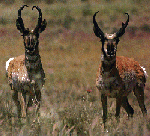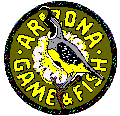|
 Description: Pronghorn antelope are only found
in North America. They are often referred to as "antelope," however, they are
not closely related to any African antelope species. The scientific name
originates from Antilo=antelope and capra=goat, thus
antelope-goat. There are five subspecies of pronghorn, three of which occur in
Arizona. They are the American pronghorn (A. a. americana), Sonoran
pronghorn (A. a. sonoriensis), and Chihuahuan pronghorn (A. a.
mexicana). Description: Pronghorn antelope are only found
in North America. They are often referred to as "antelope," however, they are
not closely related to any African antelope species. The scientific name
originates from Antilo=antelope and capra=goat, thus
antelope-goat. There are five subspecies of pronghorn, three of which occur in
Arizona. They are the American pronghorn (A. a. americana), Sonoran
pronghorn (A. a. sonoriensis), and Chihuahuan pronghorn (A. a.
mexicana).
The name "pronghorn" is derived from a forward
projection or prong on each horn. Pronghorn have true horns, in that the horn
sheath is composed of fused hairs which cover a bone core. The horn sheath is
shed each year in October-November. In comparison, deer and elk have antlers
which are composed entirely of bone and shed completely each year. Both sexes
of pronghorn have horns, but those of the female are much smaller (4 inches),
seldom exceeding the length of the ear. Horns on males reach their maximum
length, 12-20 inches, by the beginning of breeding season, July or August.
Pronghorn are not large animals when compared to deer or elk. Mature
males, called bucks, stand 36-40 inches at the shoulder and weigh 85-130
pounds. Females, or does, weigh 75-105 pounds. Pronghorn have chunky bodies
with long, slim legs. Relative to body size, they have a large windpipe, heart,
and lungs which allows them to take in large amounts of air when running. These
features combined with an extremely light bone structure, contribute to the
pronghorn's amazing speed. Pronghorn can maintain speeds of 40 mph for several
miles, reaching 60 mph in shorter bursts.
Pronghorn are striking in
appearance, with a tan body and sharply contrasting white markings on the head
and neck. The belly and lower sides are creamy white and the short tail is
surrounded by a large white rump patch. Unlike does, a buck's nose is dark,
brownish-black and he has a triangular black patch on each cheek. Pronghorn
eyes are unusually large, about 2 inches in diameter, and are set well out on
the sides of the head. This allows a wide field of vision. Biologists believe
pronghorn vision is roughly equal to looking through eight-power binoculars.
Whether or not this is true, they usually see you before you see them.
Pronghorn hair is very brittle and is shed throughout the year. During
extreme weather conditions, the hollow hair provides excellent insulation.
Pronghorn hair is also used as an alarm signal. By erecting the white rump
hair, a pronghorn alerts the herd of possible danger.
Habitat: Open grass and forest parks.
Food Preferences:
Grasses, weeds, cacti, juniper, winterfat, and
chamiso. Pronghorn are selective, opportunistic foragers. They feed on forbs,
shrubs, grasses, and sometimes cacti and domestic crops. Forbs make up the
largest part of their diet, followed by shrubs, then grasses. Forbs are
typically eaten from spring to late fall and are critical to good fawn
production. Shrubs are eaten all year, but are most important in winter when
forbs are not readily available. Grasses, though relatively unimportant, are
eaten when young and succulent. Other food types vary locally in importance.
Recently disturbed ground, such as burned areas, are often good foraging sites
because they can provide an abundance of new plant growth.
Habits:
Pronghorn are chiefly diurnal, most active in
mornings and evenings, but may be seen moving at any time. Pronghorn are
nomadic with seasonal movements often occurring over large areas. Movements are
often dependent upon the quality and quantity of habitat and vary widely among
individuals. Pronghorn tend to winter in large herds, with animals of both
sexes feeding and bedding close together. However, in mild winters bucks and
does may remain separated. During spring, pregnant does isolate themselves to
give birth. By late-spring, doe-fawn groups have formed. Bachelor herds of
young, non-territorial bucks are also common. Mature bucks are solitary at this
time, often defending a territory or harem of does. The most aggressive bucks
do most of the breeding.
Pronghorn are curious, but do not hesitate
to place plenty of distance between themselves and possible danger. When in
flight, bucks normally run with their noses pointed toward the ground while
does tend to hold their heads high. Does generally lead the herd with a buck
bringing up the rear. At long range, these behavioral characteristics help
distinguish between sexes.
Breeding notes: Normal breeding period is
August - September, average number of young - 2.
Predators or Enemies:
Coyotes, bobcats, mountain lions, golden eagles, and
wild dogs prey on pronghorn. Coyotes are the primary predator of fawns in
Arizona. Pronghorn losses due to predation vary with pronghorn and predator
numbers, habitat type, and availability of alternative food sources for
predators. Speed and exceptional eyesight are the pronghorn's best protection
from predators. A fawn's best defense from predators is to choose good bedsite
cover and to lie motionless.
Size Individual Range: 20-40 square miles
Distribution:
1,000-8,000 feet in the grasslands of northern and southern
Arizona. Pronghorn are less widely distributed today than in the mid-1800's
when numbers probably reached the tens of millions. Under pristine conditions,
pronghorn ranged west of the Mississippi River from southwestern Canada through
the Rocky Mountain region south to central Mexico. By the 1920's, pronghorn
numbers reached a low of about 30,000 with only about 650 in Arizona. Possible
factors leading to the drastic decline in pronghorn may have been subsistence
and market hunting, and disease introduced by livestock.
Today,
approximately 10,000 American pronghorn are found in Arizona, chiefly in the
north-central portion of the state. Small, scattered herds of Chihuahuan
pronghorn occur in southeastern Arizona and the endangered Sonoran pronghorn
are found in southwestern Arizona. Most of Arizona's pronghorn population is
found between 3,000-7000 feet elevation. Sometimes, northern herds occur as
high as 10,000 feet during summer. Sonoran pronghorn occupy areas below 1000
feet elevation. This range in elevation encompasses a variety of grassland
habitats ranging from desert grasslands to forest and mountain meadow.
Pronghorn prefer flat, open grassland areas, but also use rolling or broken
hills and mesa tops of less than 20 percent slope. They also use such diverse
habitats as sparse deserts, woodlands, and open forests.
Live Weight: Male - 110 lbs.; Female - 75 lbs.
Hunting hints: It's best to scout prior to hunting season.
Use binoculars to glass a large area from a high point.
 Information & photo courtesy Arizona Game & Fish
Department, Region 1-Pinetop,AZ& Amber Alexander (Game
Branch)/Richard A. Ockenfels (Research Branch) Wildlife Management
Division-Arizona Game & Fish Department. Information & photo courtesy Arizona Game & Fish
Department, Region 1-Pinetop,AZ& Amber Alexander (Game
Branch)/Richard A. Ockenfels (Research Branch) Wildlife Management
Division-Arizona Game & Fish Department.
|

 Information & photo courtesy Arizona Game & Fish
Department, Region 1-Pinetop,AZ& Amber Alexander (Game
Branch)/Richard A. Ockenfels (Research Branch) Wildlife Management
Division-Arizona Game & Fish Department.
Information & photo courtesy Arizona Game & Fish
Department, Region 1-Pinetop,AZ& Amber Alexander (Game
Branch)/Richard A. Ockenfels (Research Branch) Wildlife Management
Division-Arizona Game & Fish Department.